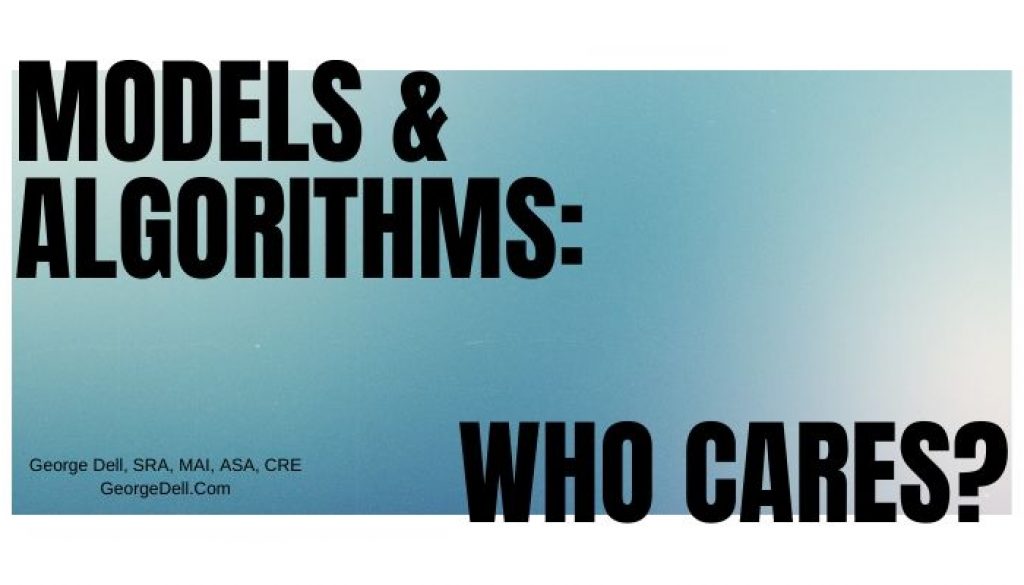We hear about models and algorithms. We are told the appraisal process is a model. And so are the cost, income, and comparison approaches. No big deal.
Ok. So now we know there are big models, and sub-models. An appraiser must know how to model. We have also heard about automated valuation models (AVMs). Hmmm. So, what an appraiser does is an MVM (manual valuation model) . . . Sounds right. The appraiser hand-picks comps, makes adjustments, and explains (reconciles) differing answers from the different approaches and methods.
And what is an algorithm? An algorithm can be defined as a precise set of rules specifying how to solve some problem. The word is used a lot for computers. (The regression formula is a small math algorithm.)
So how are models and algorithms related? Simple. A model is decided by a human – (for example which approach to use). An algorithm is a sequence of operations, by a computer. Humans are really good at seeing the big picture, finding exceptions to rules, and generalizing from limited data (like three comps). Computers are really fast and really consistent at doing a sequence of operations.
It sounds like each (humans and computers) have different strengths and weaknesses. So, what if we could combine the best of each? Well, that’s been thought of. They called them AAVMs (Appraiser Assisted Valuation Models). Kinda like the canned forms software automatically calculating a living area adjustment, from the Dollar rate the appraiser selects! Magic. Then someone asks the next step: Could we have the computer automatically calculate the $/SF adjustment? Magic. And we won’t need those pesky appraisers messing up our deals. Problem solved. . . .
The first model (multiply the $/Sq.Ft. times the difference in living area) is a mathematical algorithm – simple and sure and always exactly right. The second model, is figuring out that the $/SF rate is not the same, is not mathematical (it is modeling). The rate is different for each appraisal — and in reality, should be for each comparable! (Because things are not linear!)
This rate depends on a lot of other things, such as room counts, lot size, view, location, and everything else. If these interactions were simple, I could write an algorithm, let it do the calculation, and we do not need the appraiser! Worse yet, sometimes all the data we need to estimate an adjustment is just not available or is wrong. So again, we need someone to research, collect, measure, categorize, identify, relate, and clean. Prior to plugging into the automatic calculator algorithm.
So, we need an identifier/collector/measurer type of appraiser person. And we need an outlier/anomaly/problem definer type of appraiser person. (Sounds like the “hybrid” solution?)
Solutions in today’s digital world can only be modeled with expert digital critical thinking. This requires modern interface between the data-stream and the human brain. The solution must be visual, in the form of dashboards – designed for people with different duties and different competencies.
Required are:
- Field data entry dashboards for the collector person.
- Analyst dashboards for the valuer.
- Decision systems dashboards for reviewer/auditors and underwriters.
- And Dashboards designed for risk analysts, administrators, regulators, and top managers.
All this must be part of an integrated system, seamlessly connected.
Let’s simplify the goal. There are only two types of interaction with the data stream: First we have data enhancers/analysts; and second, we have decision makers.
The knowledge and education are available. The software is accessible and non-proprietary.
What is needed is a demand for the flexibly superior and faster result.
[themify_box color=”light-yellow”]TAAR (The Asset Analyst Report) this month, carries an extensive discussion of this topic. A modernized approach to solutions of collateral risk, investment, and equity enforcement requires optimization of the brain/machine interface. It compels clarity of the role of humans in modeling and the role of algorithms for integrated, data-stream solutions to value, risk, and microeconomic market-segment forecasting.[/themify_box]
